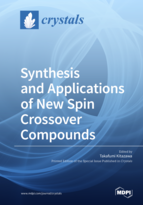Synthesis and Applications of New Spin Crossover Compounds
A special issue of Crystals (ISSN 2073-4352). This special issue belongs to the section "Macromolecular Crystals".
Deadline for manuscript submissions: closed (31 May 2019) | Viewed by 73129
Special Issue Editor
Interests: coordination chemistry; spin crossover; crystal chemistry
Special Issues, Collections and Topics in MDPI journals
Special Issue Information
Dear Colleagues,
The magnetochemistry research area of spin crossover (SCO) behavior in coordination compounds might be potentially associated with smart materials, promising materials for applications as components of memory devices, displays and sensors. 3-d block transition metal coordination compounds with d4-d7 configuration in an octahedral crystal field have a possibility of SCO phenomena between the low spin (LS) and the high spin (HS) states, being accompanied by color changes. Octahedral iron(II) SCO systems with 3d6, which can be transited between the diamagnetic (t2g)6 and the paramagnetic (t2g)4(eg)2 configuration might be widely and deeply investigated as smart materials.
Coordination materials with bistable systems between the LS and the HS states, usually triggered by external stimuli, such as temperature, light, pressure and guest molecule inclusion, are a family of potential candidates for smart materials because the change of the crystal cell volume between the HS and LS states is very large. Various SCO iron(II) coordination compounds, especially those with polymeric 1D, 2D and 3D frameworks, have been intensively investigated because their polymeric linked framework structures enhance cooperative effects which work among the SCO species resulting in SCO behavior with large hysteresis and transition temperature ranges near RT.
The interdisciplinary regions chemistry related to spin crossover phenomena are also welcome.
We are hoping to offer a portal for some of this exciting new research associated with molecular magnetism, spin crossover phenomena, coordination polymers, metallosupramolecular chemistry, multiproperty materials and functional materials with an attractive and valuable Special Issue of the open access journal, Crystals.
Prof. Dr. Takafumi Kitazawa
Guest Editor
Manuscript Submission Information
Manuscripts should be submitted online at www.mdpi.com by registering and logging in to this website. Once you are registered, click here to go to the submission form. Manuscripts can be submitted until the deadline. All submissions that pass pre-check are peer-reviewed. Accepted papers will be published continuously in the journal (as soon as accepted) and will be listed together on the special issue website. Research articles, review articles as well as short communications are invited. For planned papers, a title and short abstract (about 100 words) can be sent to the Editorial Office for announcement on this website.
Submitted manuscripts should not have been published previously, nor be under consideration for publication elsewhere (except conference proceedings papers). All manuscripts are thoroughly refereed through a single-blind peer-review process. A guide for authors and other relevant information for submission of manuscripts is available on the Instructions for Authors page. Crystals is an international peer-reviewed open access monthly journal published by MDPI.
Please visit the Instructions for Authors page before submitting a manuscript. The Article Processing Charge (APC) for publication in this open access journal is 2600 CHF (Swiss Francs). Submitted papers should be well formatted and use good English. Authors may use MDPI's English editing service prior to publication or during author revisions.
Keywords
- Spin crossover
- High spin
- Low spin
- Switching magnetic materials
- Sensor
- Smart materials
- Supuramolecular coordination polymer
- Inclusion compounds with magnetism






